数字信号处理DSP第一章1离散时间信号与系统[整理版]
- 格式:ppt
- 大小:948.50 KB
- 文档页数:5
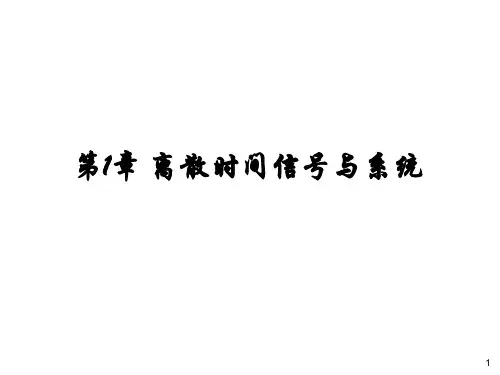
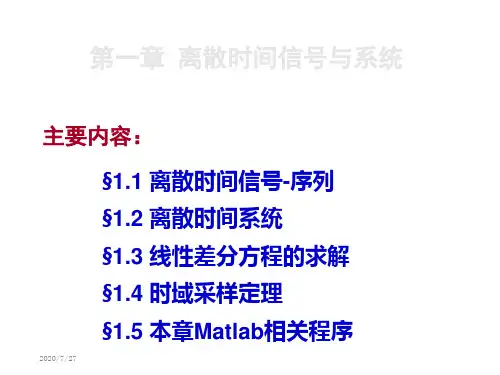
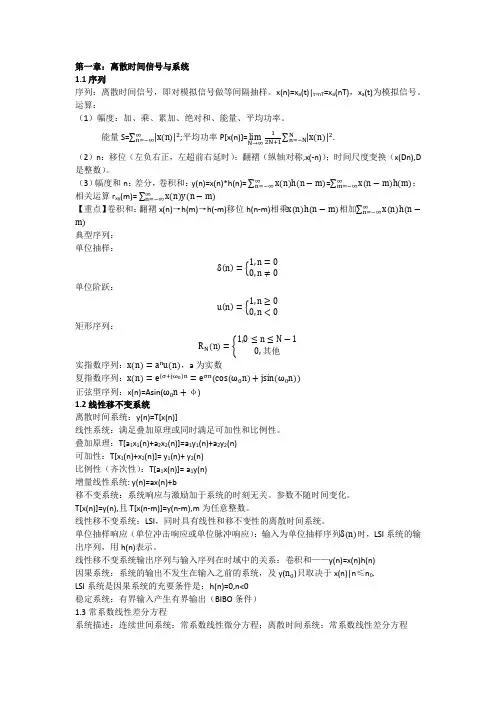
第一章:离散时间信号与系统1.1序列序列:离散时间信号,即对模拟信号做等间隔抽样。
x(n)=x a (t)|t=nT =x a (nT),x a (t)为模拟信号。
运算:(1)幅度:加、乘、累加、绝对和、能量、平均功率。
能量S= x n 2∞n=−∞;平均功率P[x(n)]=lim N →∞12N+1 x n 2N n=−N . (2)n :移位(左负右正,左超前右延时);翻褶(纵轴对称,x(-n));时间尺度变换(x(Dn),D 是整数)。
(3)幅度和n :差分,卷积和:y(n)=x(n)*h(n)= x n h(n −m)∞n=−∞= x n −m h(m)∞m=−∞;相关运算r xy (m)= x n y(n −m)∞n=−∞【重点】卷积和:翻褶x(n)→h(m)→h(-m)移位h(n-m)相乘x n h(n −m)相加 x n h(n −∞n=−∞m)典型序列:单位抽样:δ n =1,n =00,n ≠0单位阶跃:u n = 1,n ≥00,n <0矩形序列:R N (n)= 1,0≤n ≤N −10,其他实指数序列:x n =a n u n ,a 为实数复指数序列:x n =e (σ+j ω0)n =e σn (cos (ω0n)+jsin (ω0n))正弦型序列:x(n)=Asin(ω0n +φ)1.2线性移不变系统离散时间系统:y(n)=T[x(n)]线性系统:满足叠加原理或同时满足可加性和比例性。
叠加原理:T[a 1x 1(n)+a 2x 2(n)]=a 1y 1(n)+a 2y 2(n)可加性:T[x 1(n)+x 2(n)]= y 1(n)+ y 2(n)比例性(齐次性):T[a 1x(n)]= a 1y(n)增量线性系统: y(n)=ax(n)+b移不变系统:系统响应与激励加于系统的时刻无关。
参数不随时间变化。
T[x(n)]=y(n),且T[x(n-m)]=y(n-m),m 为任意整数。
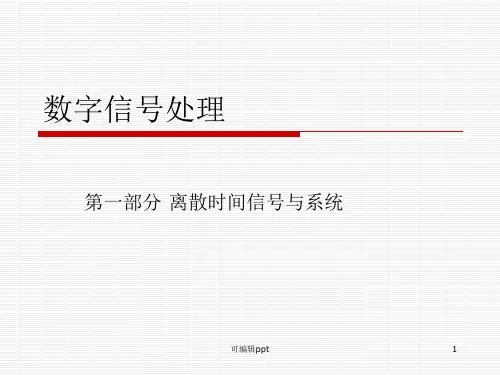

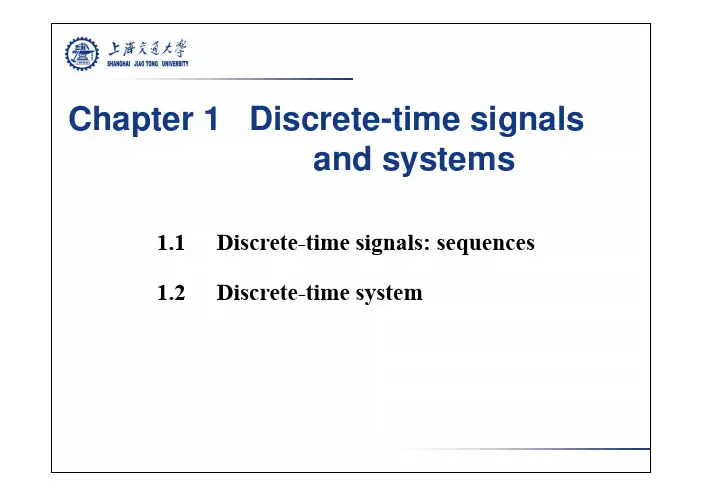
Chapter 1 Discrete-time signals p gand systems1.1 Discrete time signals: sequences1.1Discrete-time signals:sequencesy1.2Discrete-time system1.1 Discrete-time signals: sequences1.1.1 Definition and representation1.1.2 Classification of sequencei i i1.1.3 Basic sequences1.1.4 Period of sequence1.1.5 Symmetry of sequence115Symmetry of sequence1.1.6 Energy of sequence1.1.7 The basic operations of sequences1.1.1 Definition and representationDiscrete-time signals are represented mathematically as sequences (序列)of numbers. A sequence of numbers x, in which the nth number in the sequence is denoted x[n]−in which the nth number in the sequence is denoted x[n], is formally written as{}[]x x n n =∞<<+∞where n is an integer.一串按序排列的数据EXAMPLE函数法表示序列枚举法表[]0.9cos(0.2/2),010nx n n n ππ=+≤<[]{1,2,3,0,1,2, 2.5},15x n n =−−−−≤≤示序列20.5图形表示序列0102-1-0.5-2246-3-20510-1109画图程序n=-1:5;x=[1,2,1.2,0,-1,-2,-2.5];(n x '');n=0:9;y=0.9.^n .*cos(0.2*pi*n+pi/2);stem(n y '');stem (n,x, .);stem(n,y,.);产生序列的函数:cos, sin, square, sawtooth, chirp, diric, gauspuls, pulstran, rectpuls, sinc, tripuls, rand, randn.//44char:1byte byte PCM 音频序列(WAV 文件)格式//文件头:bytes (char:1byte,short:2byte,long:4byte )char strRIFF[4];//'RIFF'的ASCII 码long filelength;//4字节,文件总长度-8,低字节在前,高字节在后//'WA VE'char strWA VE[4];//WA VE 的ASCII 码char strfmt[4];//'fmt '的ASCII 码long temp;//0x00000010(均匀量化),0x00000012(非均匀量化)short isPCM;//0x0001(,6(A ,7(U 律);(线性)(律)律short channel ;//1(单声道)or 2(双声道)long Fs;//采样率,低字节在前,高字节在后long BytePerSec;//()**BitPerSample/8)channel Fs short Stereo16Bit;//(BitPerSample/8)*channel short BitPerSample ;//8or 16//'data'char strdata[4];//data 的ASCII 码longblockLen;//音频数据长度=文件总长-44byte//音频数据:1byte]左声道1byte ,[右声道1byte],左声道1byte ,[右声道1byte],…..或左声道低byte ,高byte,[右声道低byte,高byte],byte byte byte]左声道低byte ,高byte,[右声道低byte,高byte],…….注意:一般都是低字节在前,高字节在后;对于每采样8bit 的情况,存储的音频数据=实际音频+128(单极性的,即无符号数)。
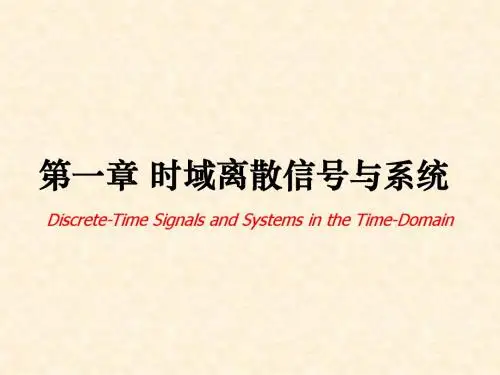



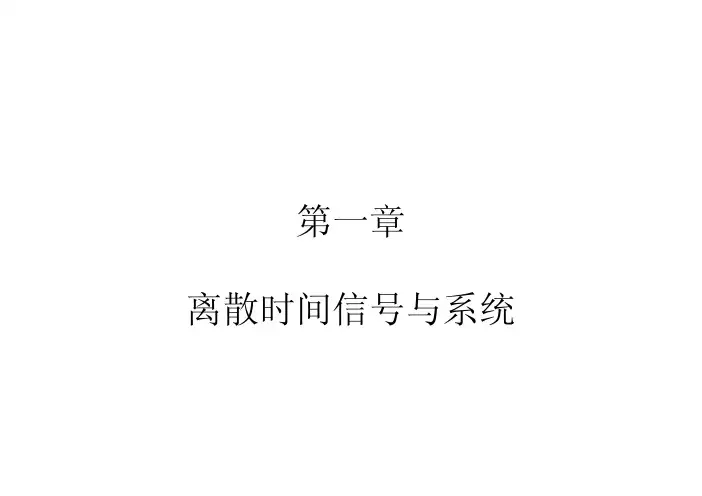
第一章离散时间信号与系统0组成的列向量0120,,)()n n n n δ−−>−组成的列向量≤≤[x,n]=stepseq(n0,n1,n2)-->u(n) (n1n n2)的波形图例1-4,画出x(n)=(0.9)n 在0≤n ≤10的波形图)()(n u a n x =()n m −=为整数,2N 2ππ例1-9,x(n)=[3,11,7,0,-1,4,2], -3≤n ≤3;h(n)=[2,3,0,-5,2,1], -1≤n ≤4,试求其卷积y(n)=x(n)*h(n)7、噪声–噪声一般为有害的,污染了信号–对于信号x(n),含有真正信号s(n)及噪声u(n)–噪声是相对的孕妇的心电信号MECG ,胎儿的心电信号FECG ()()()()()()x n s n u n x n s n u n =+=加法性噪声乘法性噪声–白噪声:含有所有频率成份,理想化的噪声模型–有色噪声:其频谱不是直线,不会含有所有频率成份–脉冲噪声:在短的时间间隔内出现的尖脉冲–噪声是随机信号,白噪声可由计算机产生rand: 均匀分布的白噪声randn:高斯分布的白噪声–白噪声的功率Pu用其方差定义,如果信号s(n)的功率为Ps,信号x(n)的信噪比为:SNR=10lg(Ps/Pu)例1-12:产生一均匀分布的白噪声信号,画出波形,并检验分布例1-13:产生零均值,功率为0.1且服从高斯分布的白噪声信号0.51/12均值为,功率为01均值为,功率为1.2 线性移不变系统1、线性系统2、移不变系统1122121212y(n)=nx(n) (2)y(n)-ay(n-1)=x(n)y(-1)=0,n 0,(1)()(),()()()()()()[()][()()]()()()[()]y n nx n y n nx n x n ax n bx n y n T x n n ax n bx n ay n by n n T x n k ≥===+==+=+=−=k 例:给定系统(1)试判断它们是否是线性,时不变?令则所以系统是线性的y(n)=T[x(n)]=nx(n)y ()()()()()[()]()k nx n k y n k n k x n k y n k T x n k y n −−=−−−≠−=而即不是时不变5、因果系统–某时刻的输出只取决于此时刻和此时刻以前的输入的系统–充分必要条件:n<0时h(n)=0–因果序列:n<0时x(n)=06、稳定系统–有界输入产生有界输出的系统–充分必要条件:绝对可和∑∞∞−∞<|)(|nh1.3 常系数差分方程1、系统的数学模型–连续时间LTI-常系数微分方程–离散时间LTI-常系数差分方程2、常系数差分方程的求解–时间域(1)迭代法(2)卷积法–变换域:ZT∑∑==−=−N k Mr r k r n x b k n y a00)()(•x(n)与y(n)的互相关函数•x(n)的自相关函数()()()xy n r m x n y n m ∞=−∞=+∑()()()()()()yx xy n n r m y n x n m x n y n m r m ∞∞=−∞=−∞=+=−=−∑∑2()()()(0)()()xx n x x n r m x n x n m r x n E x n ∞=−∞∞=−∞=+==∑∑信号自身的能量•相关函数与线性卷积关系()()*()()()()()()()*()m n g n x n y n x n m y m g m x m n y n x m y m ∞=−∞∞=−∞==−=−=∑∑线性卷积()()()()()[()]()()*()()()*()xy n n n xx r m x n y n m x n m y n x m n y n x m y m r m x m x m ∞∞=−∞=−∞∞=−∞=+=−=−−=−=−∑∑∑线性卷积:输出与单位抽样响应之间的关系相关:两个信号的相关性,与系统无关1-14()11-3)1a 1110x n 例:设信号由正弦信号加均值为零的白噪声组成,正弦信号的幅度是,白噪声的方差为,其信噪比为dB(噪声的功率大于信号功率。